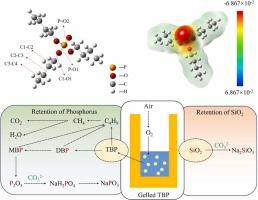Li2CO3-Na2CO3-K2CO3三元熔盐体系中胶化磷酸三丁酯降解的DFT计算研究
IF 11.3
1区 环境科学与生态学
Q1 ENGINEERING, ENVIRONMENTAL
引用次数: 0
摘要
随着全球核工业的快速发展,在PUREX过程中积累了大量的放射性磷酸三丁酯(TBP)。长期积累会造成严重的环境风险。因此,本研究提出了一种高效的熔盐氧化法(MSO)处理凝胶化TBP。综合热分析数据表明,胶凝TBP的氧化过程主要分为三个阶段。用x射线衍射光谱分析了MSO工艺后废盐的组成。傅里叶红外光谱分析表明,随着温度的升高,凝胶TBP中的初级官能团逐渐降解。扫描电镜清楚地显示了凝胶化TBP的分解过程。x射线光电子能谱结果确定了残留物质的主要形式。采用气相质谱法和色谱法对所产生的废气进行分析。此外,通过对TBP的DFT计算,推导了TBP在熔盐中的可能反应机理。在熔融状态下,碳酸盐能有效吸附P2O5,最终形成稳定的NaPO3,这是磷元素保留率达到94.90%的原因。在实验过程中,凝胶化TBP的降解率高达99.99%。本研究提出的MSO法在处理液态有机废物方面具有很大的潜力。本文章由计算机程序翻译,如有差异,请以英文原文为准。

Study on the Degradation of Gelled Tributyl Phosphate Combined with DFT Calculations in a Ternary Li2CO3-Na2CO3-K2CO3 Molten Salt System
With the rapid development of the global nuclear industry, substantial amounts of radioactive tributyl phosphate (TBP) have accumulated during the PUREX process. Prolonged accumulation poses significant environmental risks. Therefore, this study proposes an efficient molten salt oxidation (MSO) method for the treatment of gelled TBP. Comprehensive thermal analysis data indicate that the oxidation process of gelled TBP primarily consists of three stages. The composition of the waste salts after the MSO process was analyzed using X-ray diffraction spectroscopy. Fourier transform infrared spectroscopy revealed that the primary functional groups in gelled TBP were progressively degraded with increasing temperature. Scanning electron microscopy clearly illustrated the decomposition process of gelled TBP. X-ray photoelectron spectroscopy results identified the predominant forms of residual substances. The generated exhaust gas was analyzed using gas mass spectrometry and chromatography. Additionally, through DFT calculations of TBP, the possible reaction mechanism of TBP in the molten salts was deduced. In the molten state, carbonate can effectively absorb P2O5 and eventually form stable NaPO3, which is the reason for the 94.90% retention rate of phosphorus element. During the experimental process, the degradation rate of gelled TBP reached as high as 99.99%. The MSO method proposed in this study shows great potential for the treatment of liquid organic waste.
求助全文
通过发布文献求助,成功后即可免费获取论文全文。
去求助
来源期刊

Journal of Hazardous Materials
工程技术-工程:环境
CiteScore
25.40
自引率
5.90%
发文量
3059
审稿时长
58 days
期刊介绍:
The Journal of Hazardous Materials serves as a global platform for promoting cutting-edge research in the field of Environmental Science and Engineering. Our publication features a wide range of articles, including full-length research papers, review articles, and perspectives, with the aim of enhancing our understanding of the dangers and risks associated with various materials concerning public health and the environment. It is important to note that the term "environmental contaminants" refers specifically to substances that pose hazardous effects through contamination, while excluding those that do not have such impacts on the environment or human health. Moreover, we emphasize the distinction between wastes and hazardous materials in order to provide further clarity on the scope of the journal. We have a keen interest in exploring specific compounds and microbial agents that have adverse effects on the environment.
 求助内容:
求助内容: 应助结果提醒方式:
应助结果提醒方式:


